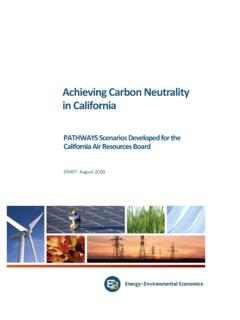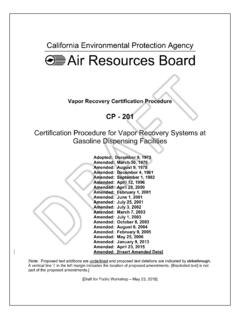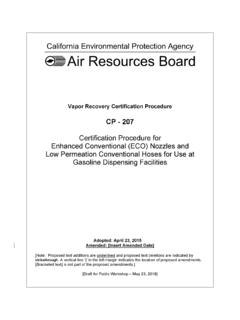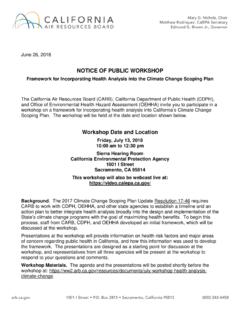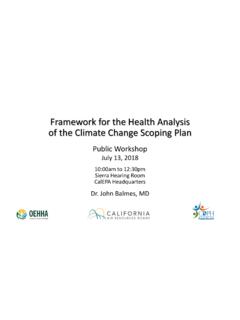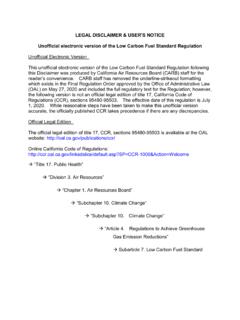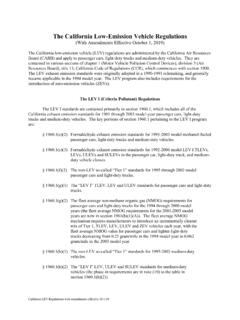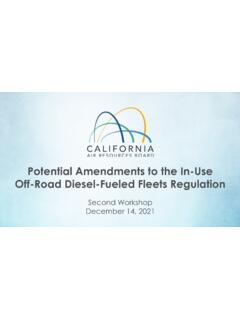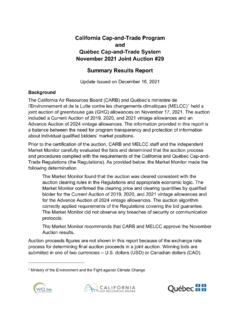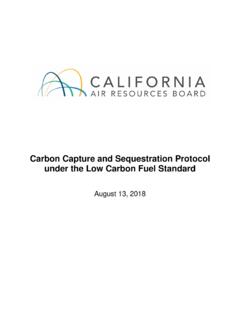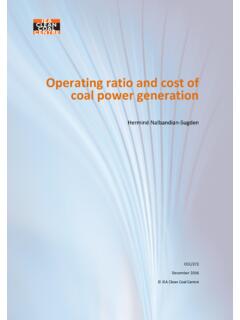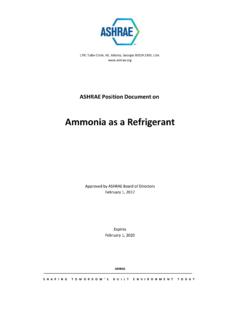Transcription of Tier 5 Rulemaking Workshop
1 Tier 5 Rulemaking WorkshopPotentialAmendments to theOff - Road DieselNew EngineRegulationsNovember 3, 20211 Outline Off-R oad Strategies Timeline What is the Tier 5 Rulemaking ? Emission Standards Criteria Pollutants Greenhouse Gases (GHG) Certification In - Use Testing and Compliance Other Potential Amendments Next Steps Low Load Cycle (LLC) Hybrid Powertrains Useful Life and Warranty Idle reduction Inducements 2 On - Board Diagnostics (OBD) OutlineOff-Road Strategies Board Dates Timeline3 TimelineSmall Off-Road Engines (SORE) Zero-Emissions ~2021 Clean Off-Road Equipment (CORE) -construction funding~2021 Zero-Emission Forklifts andIn-use Off-Road Diesel Regulation~2022 Clean Off-Road Fleet Recognition Project~2024 Tier 5 Off-Road Diesel New Engine Regulations 2024-2025 Targeted Manufacturer Rule~2025 What is the Tier 5 Rulemaking ? The proposed next generation of stringent emission standards for new off - road diesel engines Helps ensure that off - road diesel engines produced in the future will be as clean as possible Combustion standards important for off - road equipment where zero emission technology is not feasible One of several complementary programs to clean up the off-road sector in California4 RulemakingCurrent EPA and CARB Emission StandardsTier 4 Final Criteria PollutantsTier4 FinalExhaustEmissionStandardsafter2014 ModelYear (g/kW-hr)PowerCategoryApplicationPMNOxNM HCNOx+NMHCCO<19kW (<25HP) kW<56 (25 HP< 75) kW<130(75 HP<175) kW 560 (175 HP 750) >560kW(>750HP)Gen Off-Road Certification Cycles Transient Testing Nonroad Transient Test Cycle (NRTC)
2 Applies to variable speed off - road diesel engines 560 kW only Steady-State Testing Variousmodal cycles, , C1, C2, D1, D2, depending on power and speed type Applies to all variable and constant speed off - road diesel engines Opacity Testing Percent limits for in - use confirmation, 20% acceleration, 15% lugging, 50% peak Limits generally do not apply to Tier 4 engines (FEL < g/kW - hr) Not - To - Exceed (NTE) Limits Certification requirement only Same criteria and zones (control areas) as on-road NTE6 StandardsThe Need for Tier 5 Standards Current Tier 4 Final off - road diesel standards for new engines do not reflect best available control technologies (BACT) Over 50% of Tier 4 Final engines are certified without Diesel Particulate Filters (DPFs) Additional emission reductions are needed for attainment of federal and State ambient air quality standards Off - road emissions disproportionately affect disadvantaged communities Current test cycles may not adequately demonstrate emissions control duringlow load off-road engine operation7 StandardsFederal Preemption Only EPA can set emission standards for farm and construction equipment with engines less than 175hp (130 kW) Preempted equipment include most equipment powered by engines between 25 and 175 hp (19-130 kW) Examples of preempted equipment 25 hp (19 kW) include.
3 Backhoes Compressors Excavators Emissions from preempted equipment are significant in California and could become more so in the future without EPA adoption of more stringent off - road diesel standards California needs EPA cooperation in cleaning up the off-road8 Standards Pumps Skid steers Wheel loadersStandards Projected Tier 5 NOx benefits in California 2020 Mobile Source S trategy Proposal 9 Potential Tier 5 StandardsCriteria Pollutants Staff is considering (with respect to Tier 4f standards): Up to 75% reduction in NOx and PM for diesel engines < 56 kW 90% / 75% reduction in NOx / PM for engines 56 kW 560 50% reduction in NOx and PM for engines > 560 kW No changes for NMHC and CO Equipment 19 kW to be zero emission Electric equipment is already commercially available10 StandardsConsidering an Off-Road Diesel GHG Standard Currently there are no GHG standards for off - road diesel engines CO2 emissions from off - road equipment have been steadily increasing each year SB 32 requires State GHG levels to be 40% and 80% below 1990 levels by 2030 and 2050, respectively CARB staff is considering a CO2 tailpipe standard for off - road diesel engines targeting a 5 - reduction using the SwRI demonstration project s engine as a baseline11 StandardsConsidering an Off-Road Low Load Cycle (LLC)
4 Currently, there is no low load cycle for off - road engines Off - road engines frequently operate at low load up to 50% of the time SwRI data show NOx emissions from their proprietary Low Load Application Cycle (LLAC) are up to 19 timeshigher than NOx emissions from the NRTC used to certify off - road engines A representative LLC is critical for controlling real - world emissions Staff requests feedback on whether SwRI s LLAC can serve as an off - road certification cycle to ensure emissions are controlled during low load off-road : ColdNRTC: Hot 1 NRTC: Hot 2 NRTC: Hot 3 NRTC:CompositeLLACRMC C1 RMC D2 Set BSNOx [g/kW-hr]Set 1 Set 2 Set 3 Low Load Emissions Greatly Exceed Certification EmissionsDeere Baseline Individual Tailpipe NOx Results -SwRICertification BSNOx Brake Specific Oxides of Nitrogen g/kW - hr Grams Per Kilowatt - Hour NRTC Nonroad Transient Cycle LLAC Low Load Application Cycle RMC C1 8 Mode Variable Speed Ramped Modal Cycle RMC D2 5 Mode Constant Speed Ramped Modal Cycle13 Potential Off-Road Hybrid Powertrain Concepts Hybrid powertrains are currently available for the off-road Off - road hybrid powertrains use certified on - and off - road engines Emission credits are based solely on engine performance Heavy - duty on - road hybrid powertrains are certified using a modeling approach to characterize both engine and vehicle criteria and GHG emissions performance Staff requests feedback on whether there is a demand for a dedicated off - road hybrid powertrain certification procedure.
5 Staff requests feedback on whether the heavy - duty on - road hybrid powertrain certification procedure*is sufficient for certifying off - road hybrid * Useful Life Concepts Useful Life is the period of an engine's service life during which the engine is required to conform to the standards Current useful life for engines 37 kW is 10 years / 8,000 hours More representative useful life periods would reduce emissions by more than reducing the standards alone Staff is considering increasing useful life from 8,000 hours to 12,000 hours for off - road diesel engines between 56 - 560 kW Industry publications suggest major overhaul typical from 12,000 - 15,000 hours SwRI is currently demonstrating the feasibility of 12,000-hour useful life Staff requests feedback on extending useful Lengthened Minimum Warranty Periods Currently required new off - road diesel engine warranty is: 2 years / 1,500 hours < 19 kW, or < 37 kW constant speed engines > 3,000 RPM 5 years / 3,000 hours 37 kW Longer warranty periods provide emission benefits Emissions - related malfunctions that occur outside of warranty may go unrepaired to avoid expenses, especially if the malfunction does not drastically affect equipment performance Staff requests feedback regarding: What extended warranties do off - road manufacturers currently offer?
6 Why are the current emissions warranty periods adequate or inadequate?16 CertificationPossible Idle reduction Concept Idling restrictions are not currently required for off - road diesel engines Prolonged idling can adversely affect exhaust temperature and selective catalytic reduction (SCR) function resulting in higher NOx emissions Idling time for off - road diesel engines is at least as prevalent as idling time for heavy - duty on - road engines Off - road diesel engines can operate at idle 50% of the time Staff requests data to appropriately stop engines after prolonged idle, or for setting an off - road diesel idling selective catalytic reduction (SCR) Inducement Concepts Currently manufacturers are required to derate engine performance to induce vehicle operators into maintaining their SCR systems SCR is the dominant off - road technology for controlling NOx Staff proposes to codify the federal requirements of 40 CFR and (adopted in 2014/16)
7 Staff is also considering revisions to the emergency derate override provisions to minimize occurrences of abuse Staff requests comments on whether inducements should apply beyond On-Board Diagnostics (OBD) Concepts OBD currently not required for off - road engines benefits of an OBD program Clear identification of minimum repairs covered by emission warranty Facilitates diagnosis and repair leading to less downtime Leads to durability improvements Lower in - use emissions Facilitates inspections, screening of in - use engines, and in - use compliance testing Many OBD features from existing on - road heavy - duty diesel engines could be applied to off-road engines19 CertificationPossible On-Board Diagnostics (OBD) Concepts Cont. Possible OBD Requirements: Circuit continuity and out - of - range checks Major component monitoring ( , SCR, DPF, NOx sensor monitoring) Monitoring of hardware leading to inducement or derate Standardization.
8 Connector Fault information (fault codes and freeze frame) Data stream parameters NOx and CO2 tracking Real Emissions Assessment Logging (REAL) Staff requests feedback on what off - road OBD requirements should be included in the Tier 5 Off-Road In-Use Testing Program Currently, there is no manufacturer - run in - use testing program for off - road diesel engines Manufacturersonly attest that their engines comply with Not-To - Exceed (NTE) requirements In - use testing is necessary to ensure that emissions are being controlled during real - world operation The European Union has work - based in - use off - road testing and reporting requirements California has manufacturer - run in - use testing programs for light - and heavy - duty on - road engines Staff requests suggestions for amanufacturer-run TestingOther Potential Amendments Overview Out - of - State Purchases New Replacement Engines (40 CFR ) Remanufactured and Rebuilt Engines(40 CFR ) Flexibility(40 CFR ) Averaging, Banking, and Trading(40 CFR 1039 Subpart H)
9 22 Other AmendmentsOut-of-State Purchasing Out - of - state purchases have the potential to greatly diminish emission benefits in California The incentive to purchase off - road engines and equipment out - of - state is currently small, but could rise if differing standards exist Federal alignment with CARB s Tier 5 off - road diesel standards would prevent circumvention of California's regulations and loss of future emission benefits23 Other Amendments2018 CA Off - Road CI Engines New Replacement/Rebuilt/Remanufactured vs. New Engine Sales6163,59431,35705,00010,00015,00020, 00025,00030,00035,000 Replacement/Rebuilt/RemanufacturedPERA CA Off-Road EstimatesNew Engine Sales# of EnginesCARB Cert data indicates that only 2% of 2018 Off-Road CI Engine Sales in CA are replacement, rebuilt, or remanufactured AmendmentsStaff s extrapolation of Production Engine Remanufacturing Association (PERA)* data suggests remanufactured diesel engines could constitute approximately 10% of annual off - road diesel engine sales in California.
10 * Program for Equipment Manufacturers (TPEM) Flexibility is an optional compliance provision that grants additional lead - time to equipment manufacturers Flexibility dilutes the emission benefits of the new standards Additional flexibility allowances may not be necessary to comply with the Tier 5 standards Staff requests feedback and data showing the need for additional flexibility allowances under Tier 5. If granted, should flexibility allowances apply to manufacturers that produce both engines and equipment?25 Other Amendments2018 Flexibility Off-Road CI SalesNon-Flex CA SalesFlex CA SalesNon-Flex 50-state SalesFlex 50-state Sales26 Other AmendmentsAveraging, Banking, and Trading (ABT) 40 CFR 1039 Subpart H ABT is a federal provision that allows engine manufacturers to comply with the standards by averaging emission levels ABT could subject some areas of the State to higher emissions depending on the imported population of equipment with less stringent family emission limits (FEL)s ABT record keeping and reporting requirements are insufficient at both the State and federal levels Staff requests feedback and suggestions on how to improve the current ABT recordkeeping and reporting requirements to better trackFEL engines in Amendments2018 ABT Off-Road CI SalesNon-ABT CA SalesABT CA SalesNon-ABT 50-state SalesABT 50-state Sales28 Other AmendmentsQuestions?
